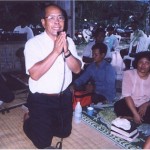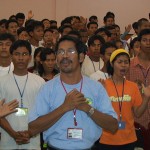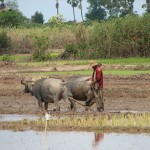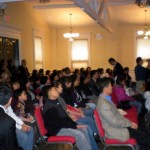January 20, 2010
Cry of the Gecko: Introduction
Cry of the Gecko: Introduction
A special thanks to Susie Koffman, Susan Smith, David Rebok, Pastor Phou Amra and Stephen Ney who helped me put this together.
Introduction: A Historical Sketch of early Cambodian History and the
Beginnings of a Christian Presence in Cambodia
This manuscript is meant to be somewhat of a brief summary of Cambodia’s recent Evangelical Church History, and it is not meant to be all exhaustive. For a more in depth look at recent Evangelical History in Cambodia up through 1996, see Rev. Don Cormack’s excellent Book, Killing Fields, Living Fields.
Many Cambodians both expatriate and nationals have contributed to this record through personal interviews and email correspondence, as well as missionaries and Relief and Development workers who served in Cambodia, or in the Thai border camps, or both. My own experiences with expatriate and national Cambodians since 1984 are also reflected in this historical outline and biographical sketch.
This introduction provides somewhat of a brief historical outline of some key events in the History of Cambodia (and the world) in order to give the reader some historical context of which to place the events and stories in this book.
Country Stats:[1]
Nation: Cambodia
Location: Southeast Asia
Capital: Phnom Penh
Population: 14 Million
Language: Khmer
Major People Groups: Khmer, Chinese, Vietnamese
Major Religions:
- Buddhism 81.5%,
- Muslim 5.4%,
- Chinese & Vietnamese Religions 7.7%
- Tribal Peoples 3.8%
- Evangelical Christianity 1.5%
Buddhism has been the official religion of Cambodia since the 12th century, following over a thousand years Brahmin (Hinduism) religious influence.
The original Cambodian people, according to Father Francois Ponchaud had the same cultural roots as people in Madagascar and Indonesia. The first inhabitants of the land called Cambodia had people more of a Polynesian make-up, pretty much resembling Cambodians of today but later combined with infusions of Chinese and Indian blood. The name, “Indo-China,” itself reflects much of the cultural and anthropological make-up of the people of that region. Although people did inhabit Cambodia well before the birth of Christ, it was only during that time that any recorded history is found, and that history coming from Chinese writings and legends.
David Chandler in A History of Cambodia, writes about the myth of Indian origin which tells us of a Brahmin named Kaundinya who came to Cambodia, possibly close to the time of a revolution in South India involving the Tamil people, who found a land of waters. Kaundinya observed a local dragon princess (nagi) named ‘Soma’ bathing in the sea. According to Chinese legend, they were from the Kampuchea Krom (Mekong Delta) area. Prince Kaundinya takes a covering and covers her nakedness and seeks permission from her father, the Naga (dragon or snake creature) to marry “Yiev Yee.” As a gift to the prince, the Dragon King swallows up all the waters of Cambodia to give him land to enable his success (at that time Cambodians were draining swamps). He later builds a capital for them and changes the name of the country to ‘Kambuja.” Kaundinya, in Cambodian legend represented the Sun, and Soma, the moon, so their legend sees not only a Cambodian marriage to India but a marriage of the Sun and the Moon. The belief in the Naga stems from around 2000 B.C. and its form is seen almost represented all parts of Cambodia’s culture, history, architecture and religion.[2]
Early Church Footprints
The Nestorian Church was an Assyrian church from the first century from Odessa (now Tblisi) in the Ukraine given its name from John Nestorius in the fifth century. Edessa was a small kingdom, a buffer state between Roman and Parthian Empires. The Assyrian Church of the East was established in Edessa in the first century of the Christian era. It is from Edessa that the message of the Gospels spread to Persia by the Christians in Edessa sending a representative (Mar Mary) to Persia to organize a church there because Christians were fleeing persecution from Rome around 200 AD. Seleucia is a town about 30 miles from Baghad (now in modern day Iraq). When the Streams of refugees turned toward Persia (Iraq) to escape persecution in the Eastern Roman Empire, Mar Papa organized this church in Seleucia in about 280 A.D.
The headquarters of the Church, Seleucia was at a strategic place on both banks of the River Tigris, the center of travel between Europe and Asia. By the middle of the sixth century (500 AD +), the Nestorian Church had spread into Egypt, Syria, Arabia, Mesopotamia, Persia, India, Ceylon, China, and Mongolia. Scholars believe that Indochina was penetrated by the Nestorian Christians as well during that time.
Rev. Paul Ellison,who spent his youth in Cambodia with his famous missionary parents, David and Muriel Ellison, and who later served in Cambodia as a C&MA missionary, states in his handout on Cambodian Church History at the CCS conference in Santa Cruz in 1991 that “church history records evidence in Vietnamese and Cambodia culture that points to early Christian missions activity in Indochina. In Damascus Syria, there was a Nestorian Church Conference which was attended by Indo-China representatives in 450 AD. In order to send a representative to this conference, the region had to have 70,000 adherents to the faith.”[3] Ellison believes that this fact alone strongly suggests that Syrian Missionaries were active in Indochina in early church times and cite examples like creation accounts, fall accounts, and flood epics among the Mon-Khmer minority groups. “Even today you can see in the countryside, the use of the cross to ward off evil spirits which has been in use for many centuries now although Cambodians don’t know the background nor can they explain the meaning behind the crosses they paint on their house other than to ward off evil spirits.” Father Ponchaud differs in his understanding as he interprets the cross to be a depiction of crow’s feet that are being used to ward of harmful spirits. Dr. Ellison’s research has found that Cham people, originally from Central Vietnam, had ancient terms for the Father, Son and the Holy Spirit.
Ellison further suggests that “In this, we see what there might have been the positive effects of early church missionary endeavors which shows in part the extent and effects of Nestorian Missions but on the negative side, there seemed to be no lasting presence as the Syrian church failed to translate scriptures because there was no written language for the peoples in the Indochina area at that time and they also apparently failed to train indigenous leaders.”[4]
Historical Outline[5]
100 AD-The Funan Period- The Funan Kingdom, being primarily a loose federation of chiefdoms involved in coastal trading, and a principality of the Chinese began around the 2nd Century.
500 AD-Sometime within the first 500 years of the Christian era, Cambodia experienced Indianization, which gave them a writing system, Brahmanism, Buddhism, and many cultural practices.[6]
700 AD- Water Chenla was attacked by pirates from the Malay Peninsula and out of those attacks came Jayavarman II (A.D. 802-50) who took the Khmer out from the power of foreign invaders and then began the Khmer nation.
802 AD-The Angkorian Period (802-1431) . The Angkorian Period is known as the golden age of the Khmer civilization.
1113-50- Suryavarman II (1113-50 AD) the greatest Angkorian King, expanded Khmer territory into Central Vietnam, then into Northern Vietnam, west into Thailand to the Irrawaddy River in Burma, and south to the Northern part of the Malaysia.
1181- Jayavarman VII (1181 AD) chased out the Cham, and, because he was a Buddhist, not Hindu like all his predecessors, he began constructing Angkor Thom and Bayon (Angkor Wat) with carved faces of the Buddha.
Post-Angkorian Period
1353- Thai forces captured Angkor and, although it was re-captured, it had been looted a number of times. Cambodia lost territory north of Siem Reap to the Lao Kingdom during this time.
1431- Angkor Thom was captured by Thai forces and the Angkor area was never again a a home to the royalty of Cambodia. The people began to migrate to the Phnom Penh area because of its financial strength and distance from the Thai people.
The Phnom Penh area by the end of the 15th century was now the home for new ruling Kings who often were conflict in with each other. In their conflicts, rulers either went to Thailand or Vietnam for support.
1630- a Cambodian King king married a Vietnamese princess and part of the deal was granting the Vietnamese permission to have customs offices in the Mekong Delta. The Vietnamese began to filter into the Delta until Cambodians were out numbered ten to one. Cambodians became a minority in their own country in the area of Kampuchea Krom or the Lower Mekong Delta. This began an era of competition between pro-Thai and pro-Vietnamese Cambodian factions, and competition between Thailand and Vietnam as to who would have the greater influence over Cambodia. Military conflict between the two countries over Cambodia last until the 1860’s.
David Chandler writes; “the History of Cambodia in the 18th and 19th Centuries is one of almost continuous invasions from Vietnam and Thailand, preceded and followed by ruinous civil wars. Phnom Penh, far from being accessible, became obscure in the trading arena.”
Catholic Missions to Cambodia
“The Name of Christ was probably first brought into Cambodia by the Portuguese and Spanish traders in the 16th century, but the stormy passage of the Roman Catholic Church in Cambodia has been well recorded in Francois Ponchaud’s book, Cathedral of the Rice Paddies. It seems that only Brahmanism and Buddhism came across from India at the beginning of the Christian era when cultural links were very strong, yet we know that a Christians did exist in Indochina from the fourth century. But the Khmer people had to wait till the 20th century to experience resurgence in Christianity, that is, apart from those living in Thailand, where the Gospel first penetrated in the 19th century.”[7]
1280 – Marco Polo’s historic visit to China
1434 –The capital of Cambodia shifts to Phnom Penh.
1490’s-Columbus discovers America and the Pope divides the World into Spanish and Portuguese halves. Vasco De Gama sails to India. Magellan sails from Spain to the Philippines but it ends up as Portuguese territory.
1500’s –King of Portugal visits Siam, and Cambodia in Longvek. Both the Cambodians and Siamese are impressed with the weapons, bows and arrows, and each country vies for rights to buy the weapons. Francois Ponchaud suggests that Catholic Christianity was first introduced to Cambodia through arms trading.
1520 – Cambodians and Thais fight for the possession of Siem Reap with Thais possessing the more modern weapons.
1535 –This year marks the beginning of colonization of Asia as the first Europeans, the Portuguese, drop their anchors off the coast of Vietnam near today’s Danang, well known as an American Marine staging area from 1965-1973.
1540 –Vietnam is politically divided, north and south.
1555 –Portuguese Catholic Missionary Gaspar de Cruz visits the Capital of Cambodia, Lovek, by the invitation of King Preah Bat Ang Chan the First. One of the King’s family members became a Christian but after he died, the Royal Family had little contact with Christianity after that. The Catholic Missionary left about a year later, disappointed in how difficult it was to make converts. 1570 was the Catholic Church’s first established presence, first by the Portuguese and then the Spanish. Many Catholic priests arrived in Cambodia after 1555 but in reaction to the Rreformation, they did not work on translating the Catholic Bible, but instead published a prayer book in the Cambodian language. This prayer book was no help at all in winning converts. Success in Vietnam kept the Catholic focus there.[8]
1560-1590
Cambodia attacks Thailand as the Thais were recently weakened by fighting with Burma. Internal weaknesses and external threats caused the Cambodian King to change his attitude toward Catholic missionaries, allowing them to preach. He tried in vain to make a non-aggression treaty with Siam but it did not happen, and he hoped that the Catholic missionaries would send word for military help which never happened.[9]
1590 –Vietnam is re-unified.
1610 –A Group of Japanese Catholics set up in Ponhhea Lloeu, 24 Kilometers north of Phnom Penh.
1613 –Vietnam divides again into two countries.
1615 –Catholic missionaries, Italian and Portuguese Jesuits arrive in Danang. French Catholics seem to have had the most success.
1660 – About 500 Catholics from Sulawesi arrive in Cambodia fleeing conflict between Catholics and Protestants there, and settle in Longvek.
1750–A French Catholic Missionary settles in Kompong Thom.
1772–Vietnam fights Cambodia at Oudong and takes many Catholic Christian prisoners to Saigon and the Thais liberate them and bring them back to Thailand.
1776 –Vietnam and Thailand continue to clash over Cambodia.
1807–Abolition of slavery was voted into law in England by the efforts of William Wilberforce.
1839 –The Opium War begins as British introduce profitable opium to China, and China tries to stop the opium trade and war begins. The British defeat China.
1840 –Destruction of all Catholic Christianity in Cambodia.
1845– Ang Dong becomes King of Cambodia
1850–Vietnamization of the Catholic Church happens as all of the Catholic structures are situated in Kampuchea Krom which is under Vietnamese control at this time. Jean Claude Miche comes to Cambodia as the French Bishop over Cambodia. He is the one who negotiates for the French with Cambodia.
1859–Naturalist Henri Mouhot rediscovers the ruins at Angkor. His discovery grabs the interest of the French who are thinking of booty and access to the Mekong as a way into Southern China.
French begin to fight the Vietnamese in Saigon.
1862- The French show of Naval Military might gains them dominion over Saigon and over the three eastern provinces of the Cochin Cchina (Mekong Delta) region.
1863 –France colonizes Cambodia, calling it a French Protectorate. During this time, a few more relatives of the King become believers but were not able to be baptized.
1867– The French make a treaty with the Thai which gives them control of Battambang and Siem Reap Province in exchange that they deny any claim over other parts of Cambodia. Losing these two provinces profoundly disturbed King Norodom, but he needed the French to send military aid to suppress a rebellion.
1875– “Hudson Taylor, leader of the China Inland Mission, issued a call to prayer in 1875 for the ‘vassal’ states to the south of China. Trading links were established with Cambodia about a thousand years previously as Chinese settlers came down into the Indo-Chinese peninsula, but China itself was then only just opening up to hear the Gospel. All around the world, groups were praying for Indo-China, and the Swiss Brethren were the first to arrive in 1902, settling in Southern Laos. God laid the burden of planting the Church on the Christian and Missionary Alliance, who sent their first workers to Vietnam in 1911, and from there, started to preach to the Kampuchea Krom people in the Mekong Delta. They found the door closed to them by the French who did not want them to compete with the Catholics inside Cambodia, but eventually God gave them the opportunity to send two missionary families in 1923, the beginning of today’s Church.[10]”
1887–Vietnam, Cambodia and Laos, grouped into the French Protectorate were called the Indochinese Union.
In the 400 years that the Catholic Church had a presence in the region, they only produced a Cambodian Prayer book but thereir was the desire to see the scriptures translated in the Khmer Language, and the first effort at this was made in the 19th century by French Priest, Marie-Joseph Guesdon, who translated portions of the gospels into Khmer to be included in the Catholic liturgy. Those passages were published at the Press of Foreign Missions in Hong Kong. [11]
1902– A Protestant French Official was concerned that Cambodians have an opportunity to hear the Good News as he saw how they were living in sin and darkness. He then arranged for a Cambodian who knew French to translate the Gospel of Luke into the Cambodian language. The Gospel of Luke was eventually printed in the Cambodian language from photographed manuscripts by the British and Foreign Bible Society in Hong Kong. The large handwritten characters made a rather large volume, just short of two inches thick. It was finished in 1910.
A few years later, an agent of the American Bible Society in Thailand was very concerned about getting the gospel to the Cambodian people. When he made a trip to visit Angkor Wat, that fact that all these Cambodian people were living with out a copy of the Bible in their own language had a profound impact on him. Upon his return to Bangkok, he found a native Thai person who knew Cambodian rather well and contracted him to translate the Gospel of Luke and Acts into the Cambodian Language. This work was done before C&MA sent their first missionaries to Cambodia. There were no printing fonts in the Cambodian language at that time and everything had to be written by hand.
1914–On July 23, Austria-Hungary issued an ultimatum to Serbia following the killing of Archduke Francis Ferdinand by a Serb assassin; the dispute led to World War I. On Aug. 4, Britain declared war on Germany while the United States proclaimed its neutrality.
1916– CMA’s Dr. Jaffrey is given official permission to minister in Haiphong, Hanoi, and Danang, but only had a short time until WWI interrupted their activities but during that time, eighteen had been baptized, and ministry expanded to all the major cities in Vietnam.
1917–There were now 5000 Cambodian Catholics in Cambodia and 60,000 Vietnamese believers.
1918–Pastor Seang Ang is born on May 19th in Takeo Province.
1919–On June 28, the Treaty of Versailles was signed in France, ending World War I.
1922- Norodom Sihanouk is born on October 31, in Phnom Penh, Cambodia.
Background of R.A. Jaffrey
R.A. Jaffrey (Robert Alexander) was born in Toronto, Canada in 1873 to Robert Jaffrey, Sr, and Sarah Bugg Jaffrey. Robert Sr., had migrated from Scotland as a poor young man and was became rather wealthy man, eventually buying the popular newspaper, the Toronto Globe. R.A. Jaffrey was born during a pioneer time, and had one older brother and three younger sisters who all brought up in the Scottish Presbyterian tradition. When he was 16, he was led to Christ by his Sunday school teacher, Miss Annie McGowan. When he was 20, he attended a rally where A.B. Simpson gave a missionary challenge which Jaffrey accepted. After meeting conflict with his father concerning his call, cut off, he enrolled at the New York Missionary Training School.[12] From there Jaffrey went out under the C&MA[13] to open up three major areas closed to the gospel at that time: South China, Indo-China, and Indonesia. He engineered the set up of four Bible Colleges in those areas, and printing ministries. Jaffrey had a heart to see the indigenous peoples raised up for the work, and because of his apostolic ministry of wanting to see new fields opened, he was responsible for thousands of conversions, and the mobilization of the many missionaries from South Asia reaching South Asians. Jaffrey refused to leave the field as the Japanese advanced in the South Pacific in the early forties. Because of his refusal, he was interned in a remote Japanese prison camp on the island of Celebes in Indonesia in 1942 and died in 1945.
Initial Difficulties on the Field
Jaffrey left the United States, cut off from his father, for Southern China in 1896, and initially met difficulties in his goals of evangelizing and church planting, but soon he transferred to Wuchow which he used as his base, where over the next 10 years or so he would prove his mettle as a leader. He was elected field leader in 1910 at the age of 38, as people respected his godly life, character, and apostolic zeal, and he had already opened a new field in China. He was known for his passion which was to reach the un-reached, open areas where gospel had not yet gone, and expanding the existing work.
Unique and Specialized Ministries that Influenced Jaffrey
Jaffrey had been strongly influenced through his publishing work at the ‘Globe’ and through A.B. Simpson’s development of training materials, and in 1911 in Wuchow, he started the Alliance Printing Press which would provide tracts, books and all sorts of literature for evangelism, discipleship, and leadership training of nationals in China. He will do this in each field he developed. Shortly after establishing the printing ministry, Jaffrey established the Chein Tao Bible School. Jaffrey, because of his own Bible School experience, was convinced they were the means to fostering a movement. He became the principal for awhile and his school provided a strategic launching pad for hundreds of indigenous Chinese leaders who would expand the ministry through leading their churches. Jaffrey believed it was the ultimate responsibility of the nationals to carry the burden of the work for their fellow countrymen. Dr. Robert Clinton points out that through the printing ministry and the Bible Schools established we can see unique methodologies[14] of focused living that will eventually lead to Jaffrey’s ultimate contributions[15].
Jaffrey again repeats this pattern in Vietnam, setting up the Alliance printing press in Hanoi in 1913. He is elected field superintendent, and in 1918, he establishes the Touranne (Danang) Bible School. He had not only had been responsible for the printing press and the Bible school, he saw to it that C&MA had a major presence in all major Vietnamese urban centers, and especially Saigon, from when he launched missionaries into Cambodia, sending the first missionaries to Phnom Penh and Battambang in 1923 to do Bible translation work and to begin a Bible School.
It seems that Hammond and Ellison who had been appointed to Cambodia had Jaffrey’s pioneer spirit as well. Jaffrey’s gifted power is what enabled his missionaries like Hammond and Ellison to catch his vision for the lost and to pioneer work among un-reached people. Jaffrey whose trust in God, character, courage, and pioneer spirit served as an example of inspiration to many during the first half of the 19th century, especially with in the C&MA. He influenced people first as a field leader, a publisher of materials, as Bible school founder and principle, missionary statesman and the results of his ministry were an estimated half a million believers in China, Vietnam, Cambodia, Laos, Thailand, and Indonesia directly or indirectly through his influence.
References
Alliance Biblique Fancaise (Paris), Handout on the Translation of the Bible into the Khmer Language. Provided by Rev. Sok Nhep Arun.
CDs of Interviews of John Ellison by Robert Shuster for archives of the Billy Graham Center in Wheaton College Oct 2, 1992, provided by John’s daughter, Ruth Ellison.
Chandler, David. A History of Cambodia, Silkworm Books, Chiang Mai, Thailand. 1998.
Clinton Dr. J. Robert, Clinton, Dr. Richard W, The Mentor’s Handbook, Barnabas Publishers, Pasadena, California, 1991.
Clinton, J. Robert. Focused Lives-Comparative Studies of Effective Leaders Who Finished Well. Altadena: Barnabas Publishers, 1995.
Compain, Alice. Article, The Khmer Church Today, EFC News & Views, Issue 1, December, 1996.
Ellison, Paul, Rev. Handout, Cambodian Evangelical Church History presented at the Cambodia Christian Service conference in San Jose. March, 1991.
Federal Research Division of the Library of Congress, Website: Cambodia, a Country Study. http://lcweb2.loc.gov/frd/cs/khtoc.html
Uon, Seila Transcripts from an interview with Pastor Seang Ang. Phnom Penh, Cambodia. 2002.
Ponchaud, Francois Cathedral of the Rice Paddy: 450 Years of History of the Church in Cambodia, Le Sarment, 1990.
Ponchaud, Francois, Elements of Khmer Mentality Lectures, Cambodian Catholic Culture Center, Phnom Penh, 27 October 2003
Website http://www.nestorian.org/history_of_the_nestorian_churc.html
Written by: Cambodianchristian.Com
Filed Under: Book, Cry of the Gecko - By Brian Maher, Introduction
Trackback URL: http://www.cambodianchristian.com/article/wp-trackback.php?p=313






